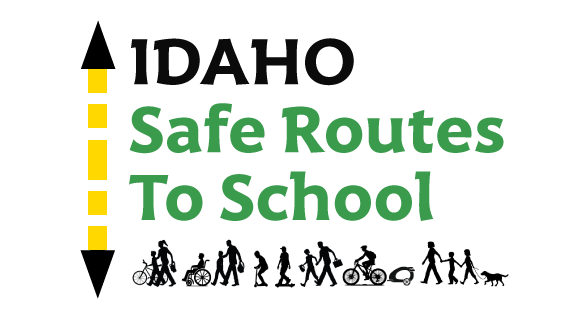What is Safe Routes to School?
Safe Routes to School (SRTS) is a national movement to improve safety around schools and on school bus/walk routes. It encourages active transportation by making it safer and easier for students to walk, bike or roll to school.
SRTS started in the 1990’s with a few individual projects. In 2005 Congress approved funding for SRTS programs in all 50 states. In 2012 funding was incorporated into the Transportation Alternatives Program (TAP)
In Idaho, SRTS programs are funded through non-infrastructure TAP grants managed by the Idaho Transportation Department (ITD). These grants are monitored by the Local Highway Technical Assistance Council (LHTAC). Non-infrastructure includes education, supplies, training, and safety planning..
Benefits
Increased Physical Activity
Safe Routes to Schools helps to increase student activity levels and reach daily physical activity levels through walking, biking or rolling to school. Physical activity has a positive impact on student behavior and can help improve academic performance.
Better Attendance
SRTS can lead to better attendance for students who do not have reliable vehicle transportation. Having a safe route students can walk, bike or roll to school provides an active alternative when other transportation is not available.
Decreased Pollution
SRTS can reduce traffic pollution near schools. The effects of air pollution on children is well documented with one study showing that children exposed to traffic emissions have an increase risk of asthma. Many school parking lots have signs to remind parents to not idle their cars while parked. Reducing the number of adults driving students to and from school reduces the number of cars contributing to emissions on school campuses.
Reduced Transportation Costs
Safe Routes to School saves time and money for everyone. Adults are not paying for the gas needed to get through a long drop off/pick up line. School Districts can reduce budgets for bussing and can put those funds towards other resources.
Community Wide Benefits
Creating safe routes to school benefits the entire community through safer streets for all which reduces crashes, promotes walking and biking and has economic benefits for the neighborhood. Decreasing the number of adults driving their students to school reduces the amount of traffic congestion during peak drive hours in the morning and afternoon.
- History of Safe Routes to School | Safe Routes Partnership
- Transportation Alternatives Program | LHTAC
- Gauderman, W. J., E. Avol, F. Lurmann, N. Kuenzli, F. Gilliland, J. Peters and R. McConnell, “Childhood Asthma and Exposure to Traffic and Nitrogen Dioxide,” Epidemiology, Volume 16, No. 6, November 2005. AND Gauderman, W.J., H. Vora, R. McConnell, K. Berhane, F. Gilliland, D. Thomas, F. Lurmann, E. Avol, N. Kunzli, M. Jerrett, and J. Peters, “Effect of exposure to traffic on lung development from 10 to 18 years of age: a cohort study,” The Lancet, Volume 368, February 2007

